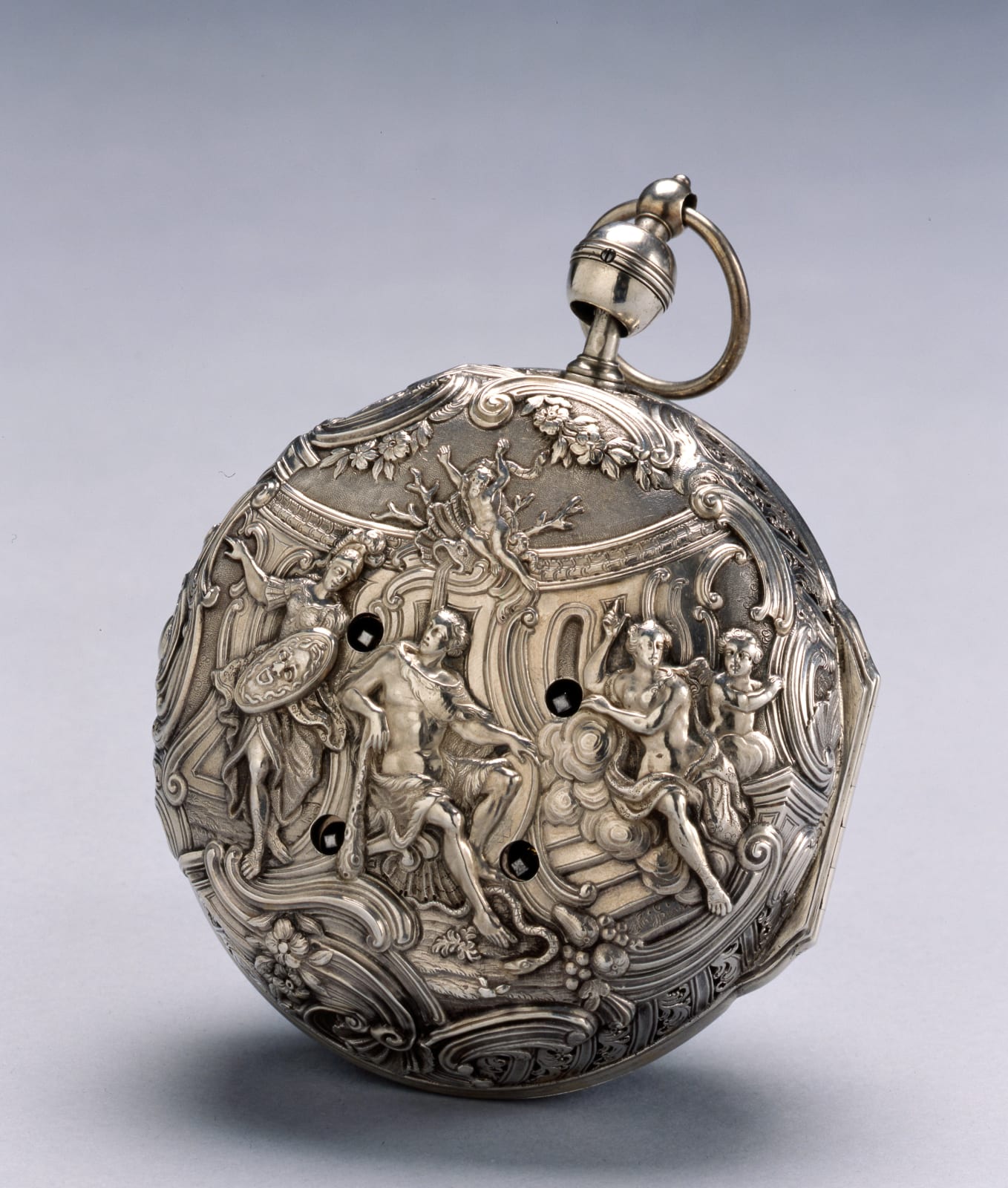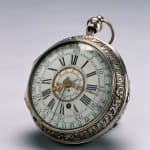Julien Le Roy France, 1686-1759
Further images
A superb and very rare Grande and Petite Sonnerie silver coach watch striking on the hours and quarters engraved Julien Le Roy á Paris and also signed F C Langpain. The white enamel dial with Roman numerals for the hours and Arabic numerals for the minutes and days of the month, with a small central revolving dial for the hour alarm indications, with square adjustment between 5 and 6, with a very fine pair of pierced gilt brass hands for the hours and minutes and blued steel pointer for the calendar and alarm indications. The movement with verge escapement, spiral balance, gilt brass cock, four hammers. The very fine case chased and engraved with fluting, scrolls and foliage around the dial and on the reverse featuring mythological scenes of Hercules seated between Minerva and Venus amid flowers and scrolls, in its own octagonal travelling case
Paris, date circa 1735
Diameter 11.3 cm.
Julien Le Roy (1686-1759), who is generally regarded as the most famous eighteenth century French clockmaker, significantly raised the standards of the Parisian clock trade. As the leader in his field his clientele included the cream of French society, not least King Louis XV and members of his court notably the Prince and Princess, the duc d'Orléans and Cardinal de Fleury. As a result of Le Roy's friendship with the British clockmaker, Henry Sully and his senior colleague, William Blakey, a number of high quality English and Dutch makers were introduced into Parisian workshops. This as well as Le Roy's own advances in the quest to improve accurate time measurement actively encouraged renewed life into the flagging Parisian trade.
Born in Tours, he trained under his father, Pierre Le Roy and by the age of 13 had already made his own clock. In 1699 Julien Le Roy moved to Paris, where he was apprenticed under Le Bon; it is said that while there he succeeded in making and completing a watch in only eight days. Received as a maître-horloger in 1713, he later became a juré of his guild; he also became a member and later a director of the Société des Arts. But his most important appointment began in 1739 when he was made 'Horloger Ordinaire du Roi' to Louis XV. He was given lodgings in the Louvre though he never occupied them. Instead he installed his son, Pierre (1717-85) and continued to operate his own business from rue de Harlay, where he remained for the rest of his life. Le Roy created exceedingly fine clocks for the King including one in a Boulle case for the Château de Fontainebleau. In 1727 he made a repeating cartel as well as two repeating watches "which are the first to have been made so that His Majesty can remove the dials Himself to see the uncovered mechanism". The following year Le Roy applied the same principle to his repeating mantle clocks.
Le Roy's innovations and improvements were substantial, notably his perfection of monumental clocks that showed mean and true time, of which his model at Hôtel des Missions Etrangères was exemplary. Le Roy also researched equation movements showing and chiming true time and advanced pull repeat mechanisms. He also resolved many problems to do with watchmaking; by taking the best and discarding the least satisfactory elements from both French and English clockmaking he ensured that watches were subsequently easier to construct and simpler to maintain. One aspect was his adoption of George Graham's cylinder, which eventually resulted in reducing the watch's thickness. George Graham was among his many admirers, who on inspecting Le Roy's work once noted "I would like to be younger so as to make watches like this".
Due to his unrivalled success, Le Roy was not limited by commercial constraints; for instance he nearly always made high quality watches and clocks in pairs so that the case and decoration perfectly matched. He generally chose the cases himself, which were provided by the very finest makers of his day such as Nicolas Le Sueur, André-Charles Boulle - father and son, the Caffieris, Charles Cressent, Le Cocq, Jean-Joseph de Saint-Germain and Robert Osmond as well as Balthazar Lieutaud, Antoine Foullet and others. Antoine-Nicolas Martinière, Nicolas Julien and possibly Elie Barbezat generally made his dials.





